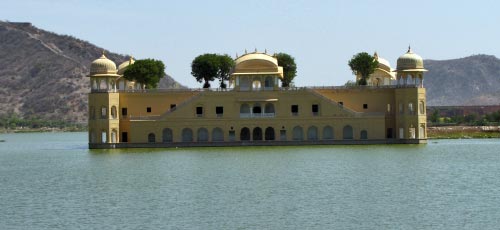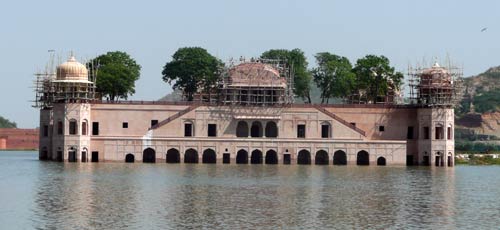Jal Mahal Jaipur, the Water Palace
Possibly the most serene sight amidst the chaos of Jaipur is the beautiful Jal Mahal Jaipur, the Water Palace. This low-rise symmetrical palace, that once was a shooting lodge for the Maharajah, appears to float in the centre of Sagar Lake. The light sand coloured stone walls of the Jal Mahal Jaipur are at a stark contrast to the deep blue of the waters of the lake, while from the innards of the palace lush foliage sprouts.

The beautiful Jal Mahal
This majestic scene makes the Jal Mahal Jaipur’s most photographed (and photograph friendly) monument but unfortunately exploration of the actual palace is off limits to the majority of visitors as it is to be transformed into an ultra exclusive restaurant.
Jal Mahal Jaipur Tourist Information
The Jal Mahal is 4km to the north of Jaipur and is located on the main Amer-Jaipur road. Most visitors to the Jal Mahal combine the visit with the Amer fort as both attractions are on the same side of Jaipur. A typical visit to the Jal Mahal will be less than 30 minutes, enough time to take some photos. There used to be gondolas which would provide romantic boat rides across the lake but these rides stopped 3 years ago. Apart from the small market stalls and camel rides there is not much else to do at the Jal Mahal.

The Jal Mahal
Travel to the Jal Mahal Jaipur
A rickshaw from Jaipur to Jal Mahal will cost between 50-100RS while the return journey should cost less than 150RS. A one day rickshaw tour that includes the Amer fort, the Jal Mahal and the monkey temple will cost around 500Rs. The Jal Mahal is connect to Jaipur by bus (bus number 5 and AC1) and the palace is on the main route between Jaipur and Amer. A single bus ticket from Jaipur will cost 10Rs and buses depart from Ajmeri gate.
Information about the Jal Mahal Jaipur
Tourists who view the Water Palace from the banks of Lake Sagar are often unaware of the technological and design achievements of the ancient palace. Though the palace only appears to be a single story there are actual a further four submerged levels. The solid stone walls hold back millions of litres of water and the special designed lime mortar has prevented water seepage for over 250 years.

The water palace is only accessible by boat
The Jal Mahal was constructed from pink sandstone and follows the classical Rajput symmetrical style which is found throughout of Rajasthan. Jaipur’s government has made a tremendous effort to improve both the palace and the surrounding lake. Less than 10 years ago the palace was an abandoned ruin with water leaking in while the lake was a foul smelling sewage outlet but today wildlife teems within the lake’s waters a the place is back to its former glory.
History of the Jal Mahal Jaipur
The Jal Mahal when translated into English means the Water Palace but the complex was never intended to be used as a palace by Maharaja Madho Singh I. Madho Singh, who constructed the Jal Mahal in 1750, simply wished it to be a lodge for himself and his entourage during his duck hunting parties. Madho’s son Madho Singh II greatly enhanced the Jal Palace during the 18th century interior of the palace adding the courtyard grounds and much of the exterior as seen today.
Jaipur India Holiday Travel Guide












